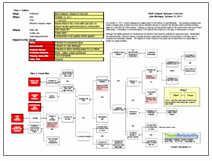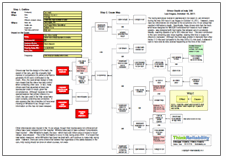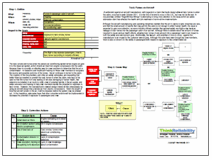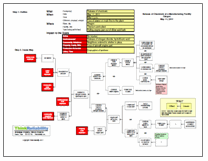 By ThinkReliability Staff
By ThinkReliability Staff
In our previous blog about Greece’s economic woes, we looked at some of the impacts the recent events have had on Greece and potentially the rest of the European Union (EU) and a timeline of the events that are part of the ongoing economic crisis. However, we stopped short of an analysis of what contributed to these impacts.
The outline, which we filled out previously, discusses an event or incident with respect to impacts to the goals of a country (economy, company, etc.). An analysis of the causes of these impacts can be made using a Cause Map, or visual root cause analysis. To do so, begin with one impacted goal and ask “why” questions to complete the analysis. For example, Greece’s financial goal is impacted because its debt rating is just above default. Why? Because the ratings agencies were concerned with Greece’s ability to repay. Why? Because their debt to revenue ratio is too high.
Whenever you encounter a situation where a ratio is too high – such as this case, where debt is too high compared to revenue – it means that the Cause Map will have two branches. Each part of the ratio is a branch. In this case, if debt to revenue is too high, it means that debt is too high and revenue is too low. Each branch can be explored in turn. There have been cases made that only one or the other branch is important, but what we’re looking for in a Cause Map is solutions that can help ameliorate the problem. Due to the severity of the issue in Greece, solutions that reduce debt and solutions that increase revenue must both be implemented in order to attempt to repair the financial standing.
 Greece’s government debt is high – caused by government spending on borrowed money when the euro was strong and interest rates were low. There are many parts to government spending, which can make their own Cause Map. Suffice to say, reducing government spending – by a lot – is necessary to reduce the debt to revenue ratio. Unfortunately, severe reductions in government spending also mean reductions in government services, and government salaries. As an example, government workers, which total 25% of the total workforce, are seeing their pay reduced 10%. As you can imagine, this reduced spending has angered some Greeks, causing riots, which have killed Greek citizens. In this case, the solution “reduced spending” also becomes a cause in another branch of the Cause Map. It’s important to remember that not all solutions are free of consequences and that solutions themselves may contribute to the overall problems.
Greece’s government debt is high – caused by government spending on borrowed money when the euro was strong and interest rates were low. There are many parts to government spending, which can make their own Cause Map. Suffice to say, reducing government spending – by a lot – is necessary to reduce the debt to revenue ratio. Unfortunately, severe reductions in government spending also mean reductions in government services, and government salaries. As an example, government workers, which total 25% of the total workforce, are seeing their pay reduced 10%. As you can imagine, this reduced spending has angered some Greeks, causing riots, which have killed Greek citizens. In this case, the solution “reduced spending” also becomes a cause in another branch of the Cause Map. It’s important to remember that not all solutions are free of consequences and that solutions themselves may contribute to the overall problems.
Greece’s revenue is insufficient to fuel their current spending levels. Tax revenue is decreased by tax evasion, high unemployment, and a shrinking economy. The Cause Map isn’t simple here either, because the shrinking economy contributes to the unemployment rate, and decreased spending can result in decreased revenue. The worldwide economic woes are contributing to the shrinking economy, but also low levels of foreign investment, caused by what is considered a difficult place to do business due to political, legal, and cultural issues. Last but not least, many governments in Greece’s situation would devalue their currency in order to regain an economic edge. However, Greece uses the Euro – so devaluing currency isn’t an option. There has been some talk of Greece dropping the Euro but a bailout by the other EU countries (itself an impact to the goals) appears to have shelved that discussion for now.
In addition to reduced tax revenue, Greece is having trouble borrowing money. As their credit rating has fallen (it now has the lowest credit rating in the world), interest rates for loans are climbing, so it is possible that Greece will still fall into bankruptcy and loans will not be repaid. This is caused by the debt to revenue ratio, and adds a circular reference to our map. This is why the economic issue has been described as a spiral – the causes feed into each other, making it difficult to climb out.
However, Greece has made admirable strides to attempt to reduce their debt and increase their revenue. Only time will tell if that, and the bailout from the EU, will be enough.
 The mudslide which took the objects and coal ash into the lake was caused by insufficient stability of a bluff overlooking the lake. The bluff’s instability was caused by degraded ground material stability mixed with water and no vegetation. The vegetation had been removed for construction. The ground in the area had been filled with coal ash – a practice allowed in previous decades. Coal ash is less stable than soil, especially when it is exposed to water. In this case, aerial images suggest that the water seeped into the area from a high water table or from an unlined retention pond used to store storm water. Although a construction project was ongoing, an environmental impact study – which may have unearthed concerns about the stability of the area – was not considered necessary.
The mudslide which took the objects and coal ash into the lake was caused by insufficient stability of a bluff overlooking the lake. The bluff’s instability was caused by degraded ground material stability mixed with water and no vegetation. The vegetation had been removed for construction. The ground in the area had been filled with coal ash – a practice allowed in previous decades. Coal ash is less stable than soil, especially when it is exposed to water. In this case, aerial images suggest that the water seeped into the area from a high water table or from an unlined retention pond used to store storm water. Although a construction project was ongoing, an environmental impact study – which may have unearthed concerns about the stability of the area – was not considered necessary.








